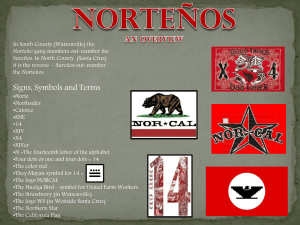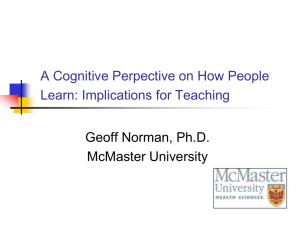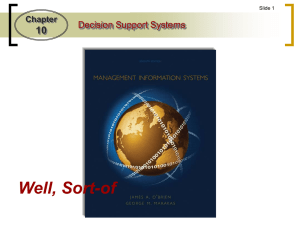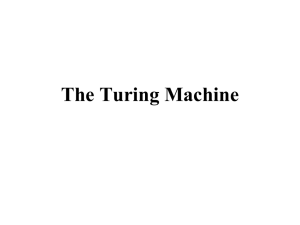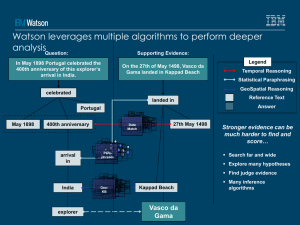Chapter22
advertisement
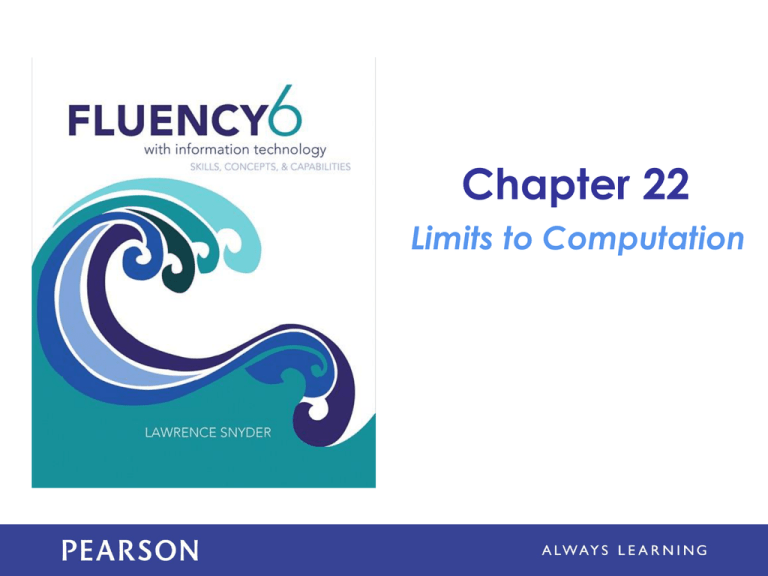
Chapter 22 Limits to Computation Learning Objectives • Explain what the Turing test was designed to show • Discuss the issue of a computer being intelligent and able to think; refer to Deep Blue and Watson • Discuss the issue of computer creativity; refer to computer generated music and art • State the meaning of the Universality Principle • State the way in which the amount of work in a program is related to the speed of the program Can Computers Think? • What is thinking? – Is it what People do? • Alan M. Turing tried to answer this question – One of the pioneers of computing – Decided to forget defining thinking – Proposed an IQ test for the computer in 1950 The Turing Test • The Turing Test – Two identical rooms (A and B) are connected to a judge who can type questions directed to either room – A human occupies one room and a computer the other – The judge’s goal is to decide based answers received, which room contains the computer – If the judge cannot decide for certain, the computer can be said to be intelligent Passing the Test • Turing’s experiment sidestepped the problem of defining thinking, and also got away from focusing on any specific ability such as performing arithmetic • When Turing conceived the test, no algorithmic process was known for analyzing English, as word processor’s grammar checkers do today Passing the Test • Computers are still a long way from being perfect • Good enough at language tasks that we can imagine a day when computers are better than most humans Acting Intelligently? • Spelling and grammar checks are based on rules (syntax) – the computer doesn’t understand the context • About Eliza (Doctor)? – Developed by MIT researcher Joseph Weizenbaum – She carried on a conversation as though she were a psychotherapist Acting Intelligently? • Eliza was programmed to keep the dialog going by asking questions and requesting more information • She took cues from words like “mother” and negative words (don’t, hate, not, etc.) • Eliza was NOT intelligent…her response was just pre-programmed AI (Artificial Intelligence) • To be intelligent, a computer has to understand a situation and reason to act on that understanding • Actions could not be scripted (preprogrammed) or predetermined • Systems would have to understand natural language and/or have real-world knowledge Playing Chess • Does not require natural language • Offered a challenging task that humans were both good at and interested in • It was predicted as early as 1952 that a computer would beat a grand master – It took more than a decade before computers could do much more than know the legal chess moves – Well established as a litmus test for AI A Game Tree • The Evaluation Function gives a score for each move – If the score is positive, it’s a good move – If the score is negative, it’s a bad one – The higher the score, the better the move • The computer must also “evaluate” or “look ahead” at the opponent’s move and see how that will affect it’s move Example of a Game Tree If there are 28 moves possible from the current position, and an average of 28 from each of those, and each of their descendants, and so on, then six moves deep (i.e., three for each side) generates 28 + 282 + 283 + 284 + 285 + 286 = 499,738,092 which is a half billion boards that the computer must try to evaluate! Using the Game Tree Tactically • Before picking a move, the computer must consider what the opponent might do • The computer considers every possible next move and evaluates them Using the Game Tree Tactically • The best move for the opponent is presumably the worst move for the computer – computer assumes the opponent will choose the move with the most negative score in the evaluation function – process is known as “look ahead” • Checking the whole game tree is generally impossible Using the Game Tree Tactically • If there are 28 moves possible from the current position, and an average of 28 from each of those, that generates a half billion boards • Picking the best move at the first level is not necessarily the best strategy – think about advantages – strategize, sacrifice, force behaviors Using Database Knowledge • The computer needs more knowledge to play the game • It uses a database of openings and endgames • Chess has been studied for so long that there is ample information about how to start and end a game • Using a database is like giving the computer “chess experience” Using Parallel Computation • Slowly chess programs got better and better • Eventually they started beating masters • Progress came with faster computers, complete databases, and better evaluation – Parallel computation: the application of several computers to one task The Deep Blue Matches • Required a large database of prior knowledge on openings and endgames • Required special-purpose hardware that allowed rapid evaluation of board positions • Deep Blue won by speed – Blue simply looked deeper into possible moves Interpreting the Outcome of the Matches • The problem was basically solved by speed – Deep Blue simply looked deeper • May have demonstrated that computers can be intelligent or that IBM’s team is intelligent • Deep Blue is completely specialized to chess What is Watson? • February 2011, IBM semantic analysis system competed and won a special edition of Jeopardy! • Game winnings were: – $77,147 for Watson, – $24,000 for Jennings – $21,000 for Rutter • Watson is a program with specialized functions and a huge database! What does Watson do? • The program is: – self-contained (not on the Internet) – parses English – formulates queries to its database – filters the results it receives – evaluates the relevance to the question – selects an answer – and gives its answer in the form of spoken English Watson Watson’s Database • The database is built from 200 million pages of unstructured input: – encyclopedias, dictionaries, blogs, magazines, and so forth • If your standard desktop computer ran the Watson program, it would take two hours to answer a Jeopardy! Question • Watson had to answer in 2–6 seconds, requiring 2,800 computers with terabytes of memory! Watson’s Learning • Researchers analyzed 20,000 previous Jeopardy! Questions for its “lexical answer type” or LAT • There were more than 2,500 different explicit LATs, and more than 10% didn’t have an explicit LAT • Even if Watson were perfect at figuring out the LAT, one time in 10 it wouldn’t even know what kind of answer to give LAT’s Acting Creatively • • • • Can a computer create art? Can it make music? What are the “rules” to be creative? Is creativity defined as: a process of breaking the rules? • But, computers only follow rules…maybe there are rules on how to break rules Is it Live? Or is it Computer? Creativity as a Spectrum • Creativity that comes from inspiration—“a flash out of the blue”—and the form that comes from hard work—“incremental revision.” (Bruce Jacob) • In Jacob’s view the hard work is algorithmic • To be inspired, the computer would have to step outside of the “established order” and invent its own rules What Part of Creativity is Algorithmic? • Consider whether a computer can be creative not as a yes/no question, but instead as an expedition • The more deeply we understand creativity, the more we find ways in which it is algorithmic • Aspects of creativity are algorithmic The Universality Principle • What makes one computer more powerful than another? – Any computer using only very simple instructions could simulate any other computer. – Known as the Universality Principle means that all computers have the same power! • The six instructions Add (remember Chapter 9), Subtract, Set_To_One, Load, Store, and Branch_On_Zero are sufficient to program any computation Practical Consequences • Universality Principle says that all computers compute the same way, and speed is the only difference • The claim that any computer can simulate any other computer has the disadvantage that simulation does the work more slowly • Although both computers can realize the same computations, they perform them at different rates Exactly the Same, But Different • If all computers are the same, why need different copies of software to run on different platforms? • All computers have equal power in that they can DO the same computations, but they don’t USE the same instructions • The processors have different instructions, different encodings, and a lot of other important difference Outmoded Computers • New software with new features runs slowly on old machines • Two reasons in support that older computers are “outmoded:” – Hardware and/or software products are often incompatible with older machines – Software vendors simply don’t support old machines. More Work, Slower Speed • There are very difficult computations with no known fast algorithm • Many problems of interest don’t have any known “practical” algorithmic solutions – For example, look at the many websites dedicated to finding the cheapest air tickets. The prices are different!!! • These are called NP-complete problems NP-complete problems • These problems are called intractable • This means that the best way to solve them is so difficult that large data sets cannot be solved with a realistic amount of computer time on any computer • In principle, the problems are solvable, in practice, they are not Unsolvable Problems • There are problems computers cannot solve at all • There are no algorithms to solve the problem! • These problems have a clear quantifiable objective Summary • Identified a tendency for people to decide that an intellectual activity isn’t considered thinking if it is algorithmic – Thinking is probably best defined as what humans do, and therefore something computers can’t do • Discussed the Turing test, an experimental setting in which we can compare the capabilities of humans with those of computers. Summary • Studied the question of computer chess and learned that computers use a game tree formulation, an evaluation function to assess board positions, and a database of openings and endgames • Studied the problem of semantic analysis as implemented in the Watson program Summary • Studied creativity, deciding it occurs on a spectrum: from algorithmic variation (Mondrian and Pollock graphics-in-a-click) through incremental revision to a flash of inspiration • Presumed that there will be further advancement, but we do not know where the “algorithmic frontier” will be drawn • Considered the Universality Principle, which implies that computers are equal in terms of what they can compute Summary • Learned that important problems, the so-called NP-complete problems, require much more computational work than the computations we do daily – Many of the problems we would like to solve are NPcomplete problems, but unfortunately the NPcomplete problems are intractable, large instances are solvable by computer only in principle, not in practice Summary • Learned the amazing fact that some computations—for example, general-purpose debugging—cannot be solved by computers, even in principle
